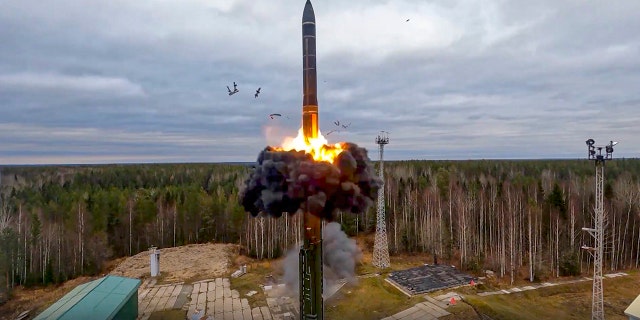The Pentagon on Thursday defended plans announced in its latest National Defense Strategy (NDS) to reduce U.S. nuclear capabilities by eliminating at least two programs despite heightened tensions with Russia.
Russian President Vladimir Putin has repeatedly threatened to use nuclear weapons as the deadly war in Ukraine rages.
But the NDS declassified Thursday showed that the U.S. has decided to retire the B83-1 gravity bomb – which is a nuclear aircraft-delivered bomb that does not contain a guidance system – along with the nuclear-armed Sea-Launched cruise Missile (SLCM-N) program.
Defense Secretary Lloyd Austin speaks during a briefing at the Pentagon in Washington, Thursday, Oct. 27, 2022.
(AP Photo/Susan Walsh)
US, RUSSIAN DEFENSE SECRETARIES SPEAK FOR SECOND TIME IN THREE DAYS AMID ‘DIRTY BOMB’ CLAIMS
When questioned by Fox News’ Jennifer Griffin on why the U.S. would choose to eliminate nuclear capabilities during a period of heightened tensions with Moscow, Defense Secretary Lloyd Austin argued “our inventory of nuclear weapons is significant.”
“I do not believe this sends a message to Putin,” Austin said. “He understands what our capability is.”
The NDS, first handed to Congress in March, was described by Austin as the Pentagon’s “north star” when it comes to U.S. defense and working with allied nations against foreign threats.
Nuclear deterrence was chief among concerns listed in the security document, particularly when it comes to Iran and North Korea.
But neither Russia nor nuclear nonproliferation made it to the top of the list when it comes to what Washington views as its number one threat – China.
Austin on Thursday made sure Moscow knew Washington does not believe it is as big of a threat to the U.S. as China.

In this handout photo taken from video released by Russian Defense Ministry Press Service on Wednesday, Oct. 26, 2022, a Yars intercontinental ballistic missile is test-fired as part of Russia’s nuclear drills from a launch site in Plesetsk, northwestern Russia.
(Russian Defense Ministry Press Service via AP)
“Unlike China, Russia cannot systemically challenge the United States in the long term,” he told reporters. “But Russian aggression does pose an immediate and sharp threat to our interests and values.
“The NDS bluntly describes Russia as an acute threat,” he said moments after portions of the NDS along with the Nuclear Posture Review and Missile Defense Review had been declassified.
Check back on this developing story.





